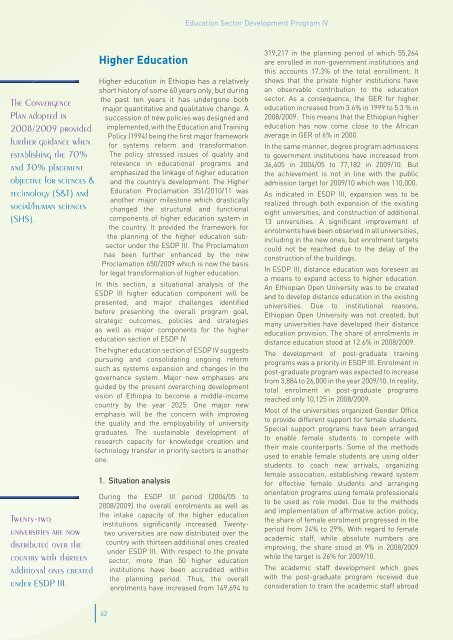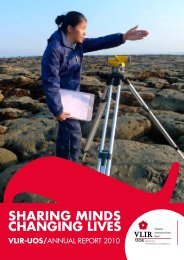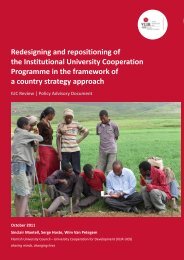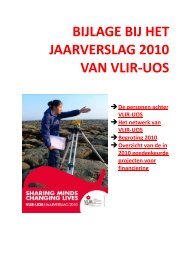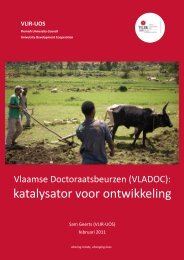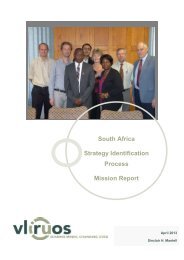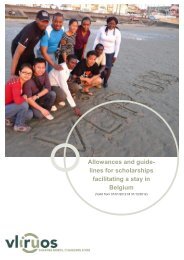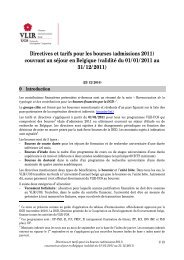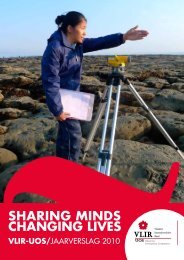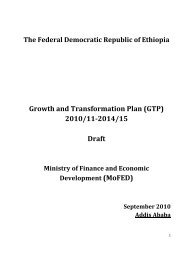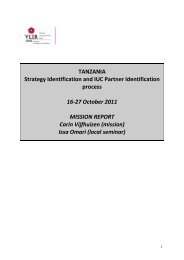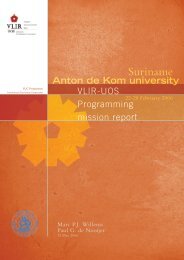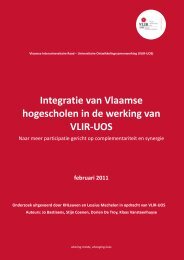Education Sector Development Program - VLIR-UOS
Education Sector Development Program - VLIR-UOS
Education Sector Development Program - VLIR-UOS
You also want an ePaper? Increase the reach of your titles
YUMPU automatically turns print PDFs into web optimized ePapers that Google loves.
<strong>Education</strong> <strong>Sector</strong> <strong>Development</strong> <strong>Program</strong> IV<br />
The Convergence<br />
Plan adopted in<br />
2008/2009 provided<br />
further guidance when<br />
establishing the 70%<br />
and 30% placement<br />
objective for sciences &<br />
technology (S&T) and<br />
social/human sciences<br />
(SHS).<br />
Twenty-two<br />
universities are now<br />
distributed over the<br />
country with thirteen<br />
additional ones created<br />
under ESDP III.<br />
Higher <strong>Education</strong><br />
Higher education in Ethiopia has a relatively<br />
short history of some 60 years only, but during<br />
the past ten years it has undergone both<br />
major quantitative and qualitative change. A<br />
succession of new policies was designed and<br />
implemented, with the <strong>Education</strong> and Training<br />
Policy (1994) being the first major framework<br />
for systems reform and transformation.<br />
The policy stressed issues of quality and<br />
relevance in educational programs and<br />
emphasized the linkage of higher education<br />
and the country’s development. The Higher<br />
<strong>Education</strong> Proclamation 351/2010/11 was<br />
another major milestone which drastically<br />
changed the structural and functional<br />
components of higher education system in<br />
the country. It provided the framework for<br />
the planning of the higher education subsector<br />
under the ESDP III. The Proclamation<br />
has been further enhanced by the new<br />
Proclamation 650/2009 which is now the basis<br />
for legal transformation of higher education.<br />
In this section, a situational analysis of the<br />
ESDP III higher education component will be<br />
presented, and major challenges identified<br />
before presenting the overall program goal,<br />
strategic outcomes, policies and strategies<br />
as well as major components for the higher<br />
education section of ESDP IV.<br />
The higher education section of ESDP IV suggests<br />
pursuing and consolidating ongoing reform<br />
such as systems expansion and changes in the<br />
governance system. Major new emphases are<br />
guided by the present overarching development<br />
vision of Ethiopia to become a middle-income<br />
country by the year 2025. One major new<br />
emphasis will be the concern with improving<br />
the quality and the employability of university<br />
graduates. The sustainable development of<br />
research capacity for knowledge creation and<br />
technology transfer in priority sectors is another<br />
one.<br />
1. Situation analysis<br />
During the ESDP III period (2004/05 to<br />
2008/2009) the overall enrolments as well as<br />
the intake capacity of the higher education<br />
institutions significantly increased. Twentytwo<br />
universities are now distributed over the<br />
country with thirteen additional ones created<br />
under ESDP III. With respect to the private<br />
sector, more than 50 higher education<br />
institutions have been accredited within<br />
the planning period. Thus, the overall<br />
enrolments have increased from 149,694 to<br />
319,217 in the planning period of which 55,264<br />
are enrolled in non-government institutions and<br />
this accounts 17.3% of the total enrollment. It<br />
shows that the private higher institutions have<br />
an observable contribution to the education<br />
sector. As a consequence, the GER for higher<br />
education increased from 3.6% in 1999 to 5.3 % in<br />
2008/2009. This means that the Ethiopian higher<br />
education has now come close to the African<br />
average in GER of 6% in 2000.<br />
In the same manner, degree program admissions<br />
to government institutions have increased from<br />
36,405 in 2004/05 to 77,182 in 2009/10. But<br />
the achievement is not in line with the public<br />
admission target for 2009/10 which was 110,000.<br />
As indicated in ESDP III, expansion was to be<br />
realized through both expansion of the existing<br />
eight universities, and construction of additional<br />
13 universities. A significant improvement of<br />
enrolments have been observed in all universities,<br />
including in the new ones, but enrolment targets<br />
could not be reached due to the delay of the<br />
construction of the buildings.<br />
In ESDP III, distance education was foreseen as<br />
a means to expand access to higher education.<br />
An Ethiopian Open University was to be created<br />
and to develop distance education in the existing<br />
universities. Due to institutional reasons,<br />
Ethiopian Open University was not created, but<br />
many universities have developed their distance<br />
education provision. The share of enrolments in<br />
distance education stood at 12.6% in 2008/2009.<br />
The development of post-graduate training<br />
programs was a priority in ESDP III. Enrolment in<br />
post-graduate program was expected to increase<br />
from 3,884 to 26,000 in the year 2009/10. In reality,<br />
total enrolment in post-graduate programs<br />
reached only 10,125 in 2008/2009.<br />
Most of the universities organized Gender Office<br />
to provide different support for female students.<br />
Special support programs have been arranged<br />
to enable female students to compete with<br />
their male counterparts. Some of the methods<br />
used to enable female students are using older<br />
students to coach new arrivals, organizing<br />
female association, establishing reward system<br />
for effective female students and arranging<br />
orientation programs using female professionals<br />
to be used as role model. Due to the methods<br />
and implementation of affirmative action policy,<br />
the share of female enrolment progressed in the<br />
period from 24% to 29%. With regard to female<br />
academic staff, while absolute numbers are<br />
improving, the share stood at 9% in 2008/2009<br />
while the target is 26% for 2009/10.<br />
The academic staff development which goes<br />
with the post-graduate program received due<br />
consideration to train the academic staff abroad<br />
62


